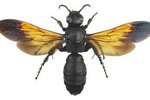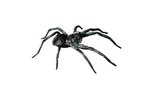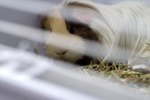Brown recluse spiders are among the most feared yet misidentified animals of all time. Actual encounters are rare due to their seclusion-seeking habits. These hermits of house and woodland generally live out their full span of years without running afoul of humanity. Though venomous, most bites resolve without treatment or serious reaction. A minority cause severe reactions ranging from anaphylaxis to gangrene and require significant medical attention.
The Hidden Fiddler
Brown recluse spiders (Loxosceles reclusa) share their genus with about 100 other species in North America, all broadly categorized as violin or fiddleback spiders. Loxosceles reclusa range from the Midwest to South Central U.S. They're so named because they prefer to spend their time in dark corners far from the tread of pretty much everyone. They can be pale yellow to dark brown, with a smooth, velvety texture and violin-shaped marking on their heads that may not be readily visible. The marking, when they have it, is darker than the body of the spider. The body and legs themselves have no pattern. Recluses share the violin marking with most other spiders in their genus, so it isn't a 100 percent sure diagnostic feature. It's a safe bet to simply avoid poking any spider whose identity you're unsure of.
Life Among the Loners
Unlike most spiders, brown recluses build webs, but don't use them to catch prey. They spend their days hiding in their silky shelters and their nights seeking food. Unlike almost all known spiders, they rarely eat live prey, preferring to scavenge dead insects. In late spring males feel the call of love, fill their palps with sperm and seek mates. After accepting these packages, female spiders are ready to make their egg sacs.
In the Sticky Sac
Adult female recluses rarely venture far from their nests -- they remain close to guard eggs and emergent spiderlings. The mother secretes about 50 fertilized eggs at a time in a mass of liquid silk that hardens into a suspended mat between 1/3 and 2/3 of an inch in diameter. Gestation time is up to 30 days, but this depends on temperature -- warm weather results in faster gestation. All egg sacs are spun in summertime. While it's possible for a single female to lay more than one clutch in a summer, few lay more than five in their lifetime.
Youth and Adulthood
Emergent spiderlings are pinprick tiny. They go through five to eight molts between birth and sexual maturity, but their ultimate adult size varies with warmth and nutrition. They tend to max out before reaching 1/2 inch of body size, though their long legs can give them a diameter around twice that. Females have larger, rounder bodies, males have longer legs. A typical life span is two years, but they occasionally live as long as four. Young spiders tend to nest close to their hatching site, so though brown recluses are rarely seen, their populations tend to be large within a habitat.
References
Resources
Writer Bio
Angela Libal began writing professionally in 2005. She has published several books, specializing in zoology and animal husbandry. Libal holds a degree in behavioral science: animal science from Moorpark College, a Bachelor of Arts from Sarah Lawrence College and is a graduate student in cryptozoology.




